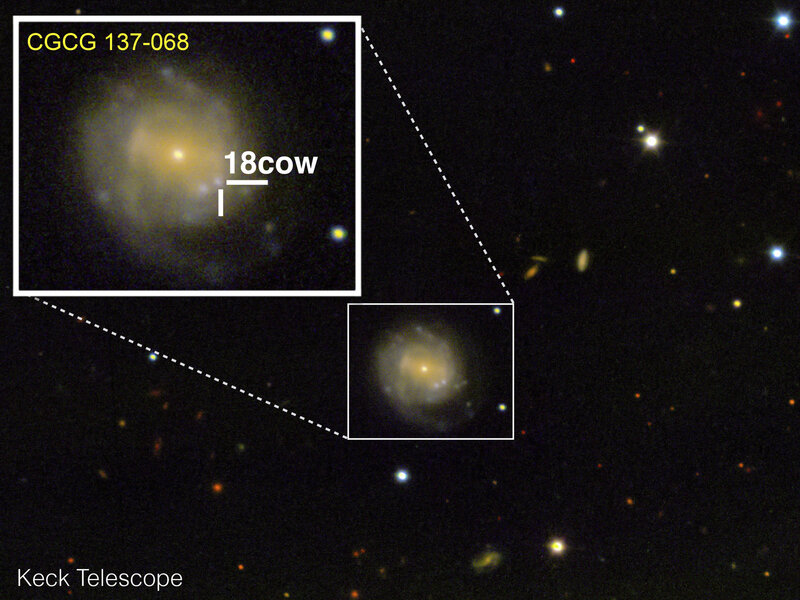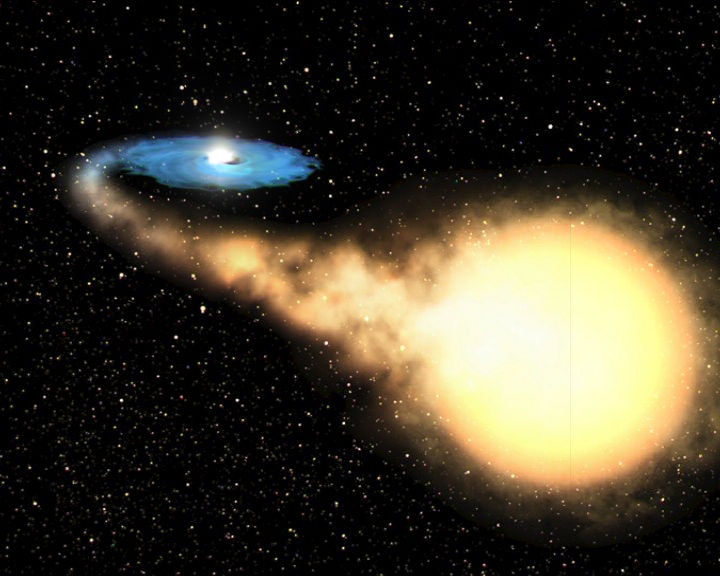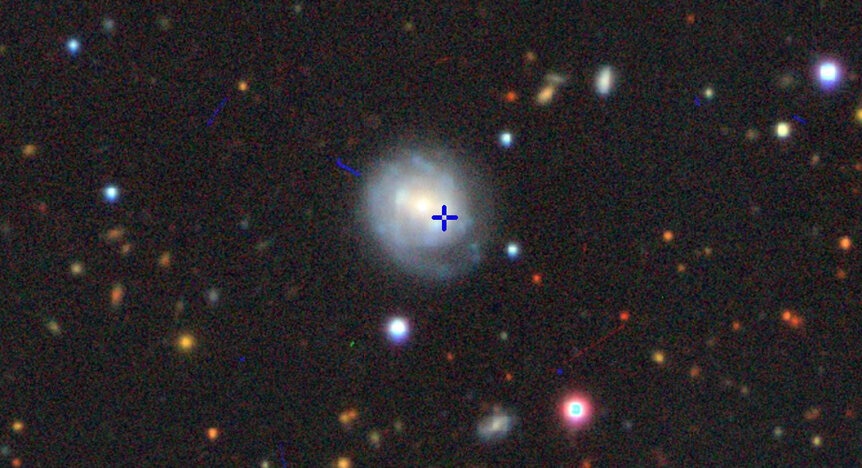Create a free profile to get unlimited access to exclusive videos, sweepstakes, and more!
Huge asymmetric exploding space cow!

Last year, astronomers saw a really weird flash of light in the sky. About all anyone can agree on is that it was an extremely big explosion seen from very far away, but other than that there are as many explanations as there are observations. Something catastrophic happened in a distant galaxy, but what?
I love stuff like this. A mystery is afoot! Watson! To the telescope!
The object was discovered in data taken by ATLAS, the Asteroid Terrestrial-impact Last Alert System. This is a pair of small telescopes in Hawaii designed to sweep the sky looking for potentially dangerous asteroids that might hit Earth, but it observes such a big area of the sky, and is sensitive to faint enough objects, that it picks up a lot of other interesting phenomena, too.
On June 16, 2018, it saw a rapid rise in brightness in a galaxy located about 200 million light years from Earth (this is well outside our local galactic neighborhood, but still relatively close in cosmic terms). The galaxy, called CGCG 137-068, is a dwarf spiral, like our Milky Way but much smaller. The event was confirmed by several other observatories, and given the designation AT2018cow — the AT for ATLAS, then the year, then the letters representing the order in which it was discovered (a for the first in the year, z for the 26th, aa for the 27th, and so on, adding letters as the discoveries number in the thousands in a single year).
So yeah, the jokes write themselves. It was an exploding cow. But this was a very, very big cow.
Right away it acted differently than your typical exploding star. It got bright fast, screaming up in brightness by a factor of 100 in less than a day (it emitted a lot of blue light, so it's part of a class of objects called a fast-rising blue optical transient, or FBOT, which in turn sounds like a sweary robot from Futurama).
The spectrum was weird, too. When you divide the light from an object into thousands of very narrow colors you can find out a lot about it, like how hot it is, what elements it has in it, how fast it's moving, and so on. Usually, a supernova has many dips and bumps in its spectrum that reveal the presence of things like hydrogen and helium, but at first 2018cow was featureless. Just a smooth spectrum. Freaky.
The total energy emitted was huge. At its peak it was blasting out 4 x 1037 Joules per second, 100 billion times the energy the Sun emits. That's way more than a supernova ever does, and is edging into gamma-ray burst territory (though GRBs usually last for seconds or minutes at most; 2018cow was pumping them out for about 8 days, so it wasn't a GRB either). Whatever was powering this thing was dialed up well past 11.
So what powered it?
Some astronomers think it was a weird kind of supernova. Usually, when a star goes kablooie, a lot of the energy comes from the initial explosion itself, then later from material slamming into thin gas around it, as well as from the decay of zillions of tons of radioactive nickel created by the titanic forces inside the supernova. But these have very distinctive signatures in the light, and none was seen in the explosion's spectrum.
Another team posits a much more exotic and awesome event. They think the characteristics best match — get this — a white dwarf torn to shreds by a black hole!
A white dwarf is a superdense ball of matter that used to be the core of a star like the Sun. As the star aged, it blew off its outer layers, revealing the naked core to space. This material is packed so tightly that a cube the size of a six-sided die would weigh a metric ton!
In their scenario, the white dwarf wandered too close to a black hole, and while a white dwarf's gravity is fierce, it still loses when it fights to the death with a black hole. The incredible gravitational force tore the white dwarf to vapor, releasing huge amounts of energy. Some of the material fell into the hole, some formed a disk around it, and some blasted away at high speed. To make everything work, the black hole would need to have a mass of something like 100,000 to one million times that of the Sun. We call these intermediate mass black holes (between the masses of ones that form from stars and supermassive ones that sit in the centers of galaxies).
This idea does match quite a bit of what was seen, but has a possibly fatal problem. Days after the initial event, a lot of the energy emitted was in the millimeter-wavelength range (longer wavelengths than infrared, but shorter than radio). This makes sense if there was a lot of relatively dense gas around the event, up to some fraction of a light year away, with debris from the explosion hitting it. But an intermediate mass black hole sitting inside this material would pull it in. That stuff would form a disk, heat up, and start blasting out tons of energy.
Nothing like that is seen. So, like I said, that's a big problem. I love this idea — and we've seen quite a few stars ripped apart by black holes now — but it doesn't work very well as an explanation.
So what is it? Well, we have to go back to the first idea, that a star blew up. There are a few kinds of supernovae that do a better job fitting what's seen. Maybe the star was a huge blue supergiant. At the end of its life it tried to blow up, but couldn't quite muster the energy needed. Its core collapsed to a black hole, and the remaining matter from the star swirled around the black hole in a disk. This could form twin jets, beams of matter and energy shooting out at high speed from the poles of the disk.
That could explain some aspects of 2018cow as well, like the fact that there's a huge range of velocities seen in the material. Some is moving at 16,000 kilometers per second, while other stuff is more lazy. The jets can accelerate matter to very high speeds, while material closer to the disk's equator would not get the same kick. A normal supernova explosion is more symmetric, expanding in a sphere, and couldn't pull this off, so 2018cow must have been far more asymmetric a blast.
This gets more complicated. Maybe it didn't form a black hole at all, but instead the collapsing star's core could've formed a magnetar. That's a super-high-energy neutron star, spinning madly, and generating such a fierce magnetic field that it rivals (and surpasses!) the ridiculously strong gravity near the surface. That would explain some of the late-time behavior from the event, as well as some other details in the initial observations.
If you're getting the idea we're not really sure what happened here, well, yeah. The only obvious thing about this event is that it's a mess. Some ideas seem to explain some aspects, but no one idea appears to cover everything. Clearly, something very odd happened in this distant galaxy, probably involving a supernova of some kind, but the details are irritatingly difficult to understand.
Here's an interesting thought, though: Because it's not so terribly far away in a cosmic sense, it seems likely it's not as rare an event as you might think. We should be able to detect events like this much farther away, encompassing a much larger volume of space. The fact that this one is close implies strongly it happens a lot. That means we need to be more vigilant monitoring the sky, getting observations of these things early on, right after they happen (since it brightened so quickly) and maintaining those observations for a long time after (so that we can see what happens in later times, which is important if expanding debris is interacting with material around it weeks or months later). Once we see enough of them, we'll have a better idea how they form.
That's something I'd very much like to know. Explosions like this are critical for the evolution of the Universe; they create the elements we are made of, seeding space with the ingredients necessary to create more stars, more planets, and, perhaps, more things like us. There are a lot of puzzle pieces to this mystery, and the more we have, the better we'll be able to fit them better.






























